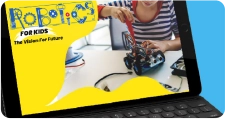

Prashant Pundir
Augmented Reality for Kids: All You Need To Know
Traditional classroom learning techniques are becoming irrelevant as technology is evolving on a daily basis. Education is becoming more digitized, engaging, and interactive as a byproduct of emerging technologies. Augmented Reality is at the heart of all of these technologies (AR).
When it comes to augmented reality, it isn’t a new concept. It has been around for a long time. Remember when Pokémon Go was the rage among enthusiasts a few years back? Today, there’s Facebook that has entered ‘Metaverse’ in Full Force as AR/VR Chief takes over the CTO role. Andrew Bosworth has overseen Facebook’s AR/VR operations, which provided the foundational technology for Mark Zuckerberg’s “Metaverse.”
Over the next few years, technology is expected to grow at an unprecedented rate. The augmented reality’s market worth is anticipated to increase from 3.5 billion dollars in 2017 to 198 billion dollars in 2025.
How are Informational Augmented Reality Assisting Kids Learn Better?
Augmented reality for kids is a vast subject. Did you know that augmented reality games have already been proven to enhance the development of young kids? AR games or activities that are highly interactive are known to include a genuine playing experience for your child.
In the world of augmented reality, a virtual environment is overlaid on the real world. The same can be accessed using a smartphone with a camera and an appropriate AR app or game. Kids’ apps with augmented reality are gaining a lot of traction these days.
The online app market is flooded with classroom applications and self-learning apps with AR to assist students to study more dynamically, safely, and productively. Everyone benefits from the cutting-edge technology that AR offers- whether it is pre-schoolers or university students.
Key Benefits of Augmented Reality in Education
The traditional learning environment is about to be transformed by augmented reality for kids. AR can make learning sessions more engaging and collaborative by providing visual representations that integrate seamlessly with the surrounding world. It can help kids understand concepts in a coherent way. Students will be able to comprehend how things work in the actual world and retain this information for a prolonged period of time.
Let’s have a look at some of the most important advantages of augmented reality for kids in education:
1. Anytime, Anywhere Access to Learning Material
Augmented reality (AR) for kids can help transform traditional textbooks, printed materials, and physical models. Students may be able to access study materials from anywhere, at any time, thanks to augmented reality.
2. Improved Engagement and Interest
AR makes education a more participatory and gamified experience. It motivates the students to be more interested during the learning sessions.
3. Effective Learning Process
Through the implementation of AR, students can grasp the working knowledge of various things instead of mugging theoretical knowledge. As a result, individuals develop a better understanding and are able to retain information for a longer period.
4. Enhanced Collaboration
AR for kids helps to learn as a community and strengthens their ability to work collaboratively.
5. Experience a Better Learning Environment
AR games promise to provide a more engaging and comprehensive learning experience for kids. AR games have the ability to develop a love for learning in them. The kids acquire practical learning experiences while interacting with a realistic and lifelike environment.
6. Special Equipment is Not Required
These augmented reality apps for kids can be used on any computer, laptop, or smartphone. As a consequence, no special device installation is required, and hence no extra costs are incurred.
Let’s have a look at some outstanding augmented reality apps for education that are transforming the business now that we’ve covered the advantages of adopting Augmented Reality in education. So, let’s get started.
Wonderscope is like stepping into a highly interactive story. The kids need to read the lines aloud to participate and communicate with the characters, as well as to assist them in solving challenges.
Consider ‘My Very Hungry Caterpillar’ to be the Tamagotchi of the twenty-first century. From hatching the bug from an egg or retrieving yummy fruit from a nearby tree for it to eat to tucking it into bed when it gets tired, your child may bring Eric Carle’s beloved character to life. Keep an eye out for the Grumpy Ladybug!
Have a curious child who asks you a lot of questions, such as “How does a toaster work?” or “How does the inside of the earth look like?”. Then Jigspace is the answer! JigSpace works on the same principle as a 3D search engine- visual answers for queries.
Quiver is an app designed by QuiverVision that allows children to participate with 3D objects created using augmented reality. Users can access and print free trigger images from the QuiverVision website. These printable graphics can be colored and personalized by children.
Anatomy 4D is an app that helps healthcare students and professionals better comprehend human anatomy. Anatomy 4D leverages an interactive AR experience to allow students to study everything pertaining to human anatomy, including organs, organ systems, and bone structure. It helps one understand how the organs and various systems are integrated with the human body.
Planets, stars, as well as galaxies are discovered using your device’s compass as an orientation. The application also allows the user to search for and locate a certain star or planet anywhere at any given time. Originally known as ‘Google Sky Map,’ Sky Map was later given up by Google, turned open-source, and rebranded as ‘Sky Map.’
ARki is an app that generates a three-dimensional model of a design and renders it in augmented reality. Other features comprise material selection, recording customizable views of models in both a movie and 3-D format, and distributing the outcomes via email or social media.
Final Thoughts
So you can see how all of these apps enhance (or, in some cases, supersede) traditional learning approaches. With the rapid expansion of digital technology and hardware, AR will certainly become more accessible in the next few years. As a consequence, it won’t be long before you see an AR-based school system.
If you have any questions on Augmented Reality, please contact our experts at inquiry@stage.moonpreneur.com.











